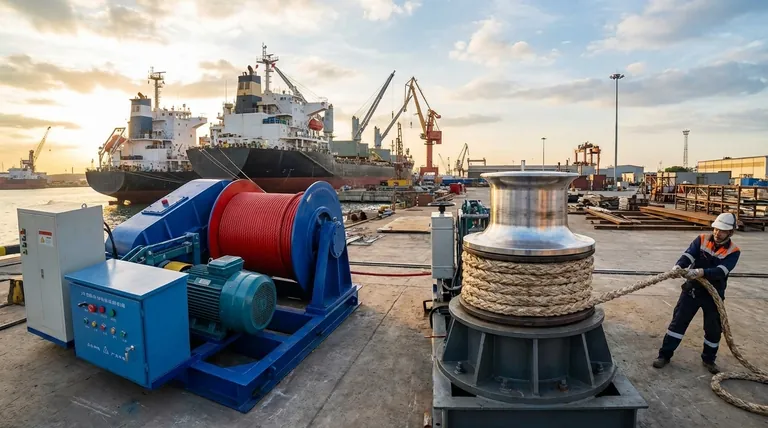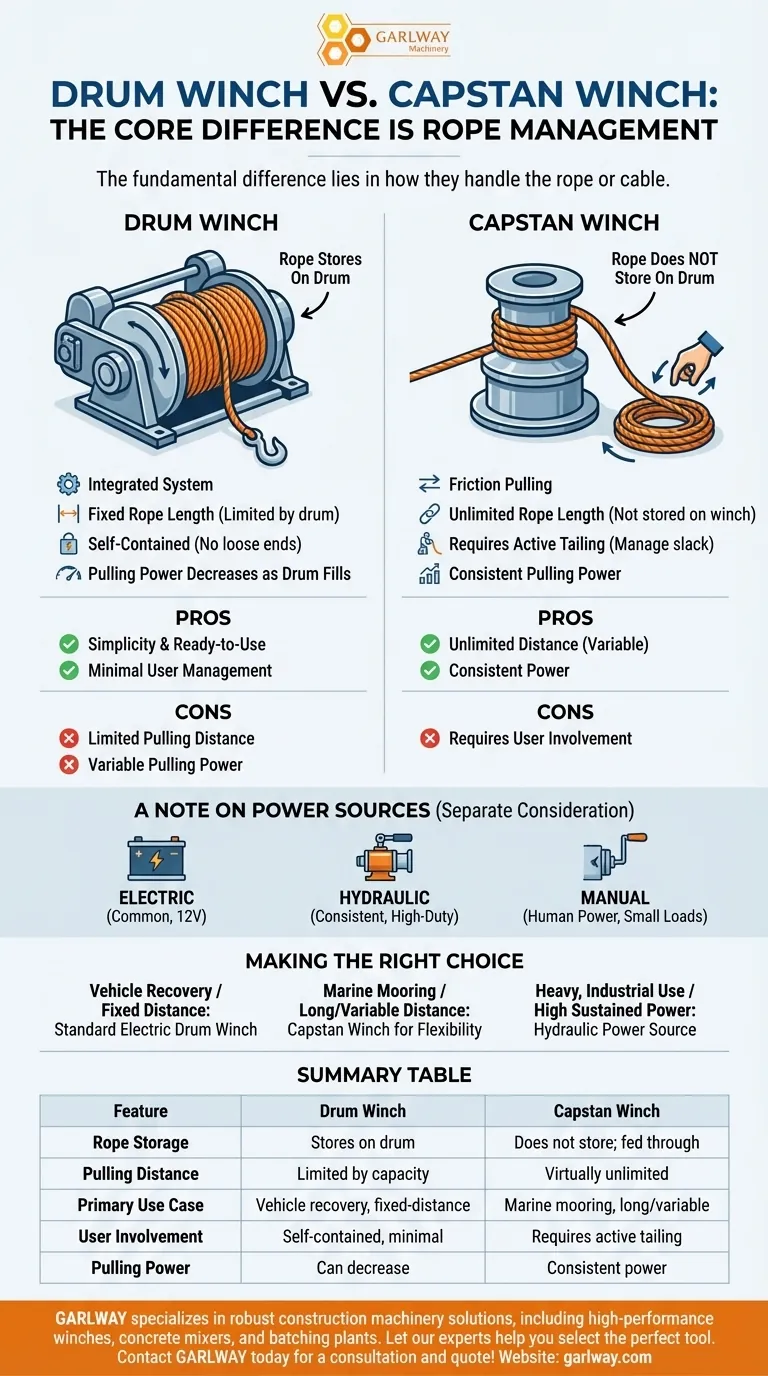The fundamental difference between a drum winch and a capstan winch lies entirely in how they handle the rope or cable. A traditional drum winch both pulls and stores its entire fixed length of rope on the drum itself. A capstan winch, however, only uses its drum to provide pulling friction; the rope is not stored on it, allowing for a virtually unlimited pulling distance.
The choice between a drum and a capstan winch isn't about the power source, but about rope management. Drum winches offer self-contained simplicity for a fixed distance, while capstan winches provide unmatched flexibility for variable and long-distance pulling.

The Core Difference: Rope Management and Storage
The mechanical design of each winch dictates its primary use case. Understanding how each manages the pulling line is the key to selecting the right tool.
How a Drum Winch Works
A drum winch is an integrated system. The entire length of the cable or rope is wound neatly onto the drum.
When you operate the winch, a motor and gearbox turn the drum, which reels the cable in, pulling the load and storing the cable simultaneously. This is the most common design found in applications like vehicle recovery.
The entire assembly—motor, brake, gearbox, and drum—is typically mounted together on a single frame.
How a Capstan Winch Works
A capstan winch uses a smaller, vertically or horizontally oriented drum, known as a capstan head. It is designed for pulling, not for storage.
To use it, you wrap the rope around the rotating capstan head a few times. The friction between the rope and the capstan generates immense pulling force.
Crucially, the rope does not accumulate on the capstan. As the capstan turns, you must manually pull on the loose end of the rope (a process called "tailing") to maintain tension and manage the slack.
Understanding the Trade-offs
Each design presents a distinct set of advantages and disadvantages based on its rope management strategy.
Drum Winch: Pros & Cons
The main advantage of a drum winch is its simplicity and self-contained nature. The rope is always spooled and ready for use, and there is no need to manage a loose tail end.
However, its primary limitation is the fixed rope length. You are constrained by how much rope can physically fit on the drum. Furthermore, the winch's pulling power can slightly decrease as the drum fills with rope, because the effective diameter increases.
Capstan Winch: Pros & Cons
The greatest benefit of a capstan winch is its unlimited rope length. Since the rope doesn't spool onto the device, you can pull a load across any distance, limited only by the length of rope you have available.
This design also provides consistent pulling power, as the diameter of the capstan never changes. The main drawback is that it requires more active user involvement to manage the slack rope.
A Note on Power Sources
It is important not to confuse the winch mechanism (drum vs. capstan) with its power source. Both types can be powered in different ways.
A Separate Consideration
The choice between an electric, hydraulic, or manual winch is a separate decision based on your power availability, installation constraints, and performance needs.
Common Power Types
Electric winches are the most common, typically powered by a 12-volt vehicle battery. They are relatively easy to install and maintain.
Hydraulic winches run off a hydraulic system, offering very consistent and high-duty power, but they require a more complex installation.
Manual winches rely on human power, such as hand-cranking, and are best suited for smaller loads and infrequent use.
Making the Right Choice for Your Application
Your final decision should be guided by the specific demands of your task.
- If your primary focus is straightforward vehicle recovery or fixed-distance pulling: A standard electric drum winch is the most practical and common choice.
- If your primary focus is marine mooring, utility work, or any task requiring long or variable pulling distances: A capstan winch provides unparalleled flexibility.
- If your primary focus is heavy, industrial use with a need for high, sustained power: A hydraulic power source is often the best option for either a drum or capstan winch.
Understanding this core distinction in design empowers you to select the right tool for the job.
Summary Table:
| Feature | Drum Winch | Capstan Winch |
|---|---|---|
| Rope Storage | Stores rope on the drum | Does not store rope; rope is fed through |
| Pulling Distance | Limited by drum capacity | Virtually unlimited |
| Primary Use Case | Vehicle recovery, fixed-distance pulling | Marine mooring, long/variable-distance pulling |
| User Involvement | Self-contained; minimal management | Requires active tailing of the rope |
| Pulling Power | Can decrease as drum fills | Consistent power |
Still unsure which winch is right for your project?
GARLWAY specializes in providing robust construction machinery solutions. Whether you're a contractor needing a reliable drum winch for vehicle recovery or require the flexible, long-distance pulling of a capstan winch for marine or utility work, we have the expertise and equipment to meet your demands.
We offer a range of high-performance winches, concrete mixers, and concrete batching plants designed for durability and efficiency on any job site.
Let our experts help you select the perfect tool. Contact GARLWAY today for a personalized consultation and quote!
Visual Guide

Related Products
- Best 18000 Pound Drum Anchor Trailer Winch
- Ready Mixer Machine for Construction Ready Mix Machinery
- Electric and Hydraulic Winch for Heavy Duty Applications
- Commercial Construction Mixer Machine for Soil Cement Mixing Concrete
- Warn Winch Windlass Boat Trailer Winch
People Also Ask
- What is the primary function of trailer winches? Effortlessly Load Heavy Boats & Equipment
- How are trailer winches rated? A Guide to Safe & Effective Load Capacity
- How does using a trailer mounted winch reduce the need for additional equipment? Streamline Your Job Site Logistics
- How are trailer winch sizes determined? Match Capacity to Your Boat's Weight for Safe Loading
- What factors should be considered when choosing a trailer winch? Ensure Safe & Efficient Load Handling



















